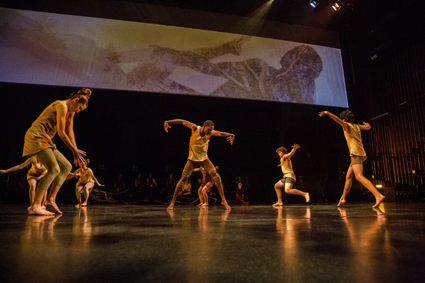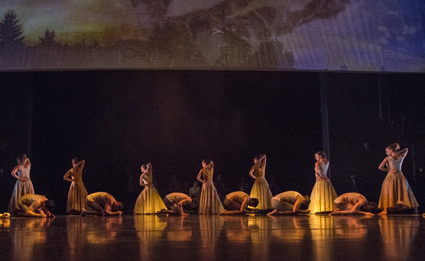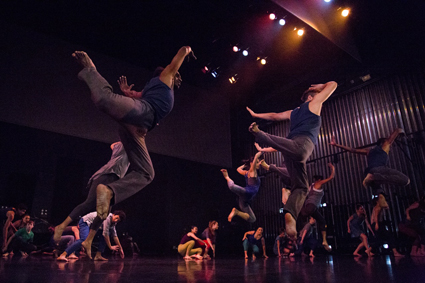Sharing country
Zsuzsanna Soboslay: QL2’s Quantum Leap, Hit the Floor Together

Quantum Leap ensemble, Hit the floor together, QL2 Dance
photo Lorna Sim
Quantum Leap ensemble, Hit the floor together, QL2 Dance
“I barely danced before this. It was extremely hard work. You better enjoy it.” Richard Allan, dancer, Hit the Floor Together
The value of youth dance development is bifold. Young performers reach into what they can’t yet imagine; emerging choreographers get to stretch their limbs. And sometimes one gets to see both choreographer and performers spread some surprisingly eloquent wings.
Hit the Floor Together is a project initiated by Daniel Riley McKinley (a choreographer with Bangarra Dance Theatre), incorporating young QL2 and regional dancers with older NAISDA (National Aboriginal Islander Skills Development Association) Dance College trainees. . It begins with Bearcage Productions’ short film revealing a grid of dancers in a long scrubby horizon, establishing some of this show’s major themes. How do Australians of different backgrounds understand identity? What are the cultural differences? The film establishes an interplay of surfaces and excavations. Adam Ventoura’s soundscape scrabbles glissandi (contemporary doubt) and muted thunderclaps (a threatening future) against a pulsing ostinato (our collective mythic histories).

Quantum Leap ensemble, Hit the floor together, QL2 Dance
photo Lorna Sim
Quantum Leap ensemble, Hit the floor together, QL2 Dance
The projection fades, dusk to the opening’s daytime to begin McKinley’s Where We Gather. The stage is backlit to reveal dancers possibly less human than spinifex. As they blow to the wings, others appear, still, like cassowaries on a mound. Or are they already soil and ground?
The scrim remains a projection screen but is scrolled up to a narrow strip along the gantry, becoming one layer of visual geology in the landscape of the stage. A pan shot projection of arid land is intercepted by shadows of birds’ wings. Below this film, dancers become trios and sextets—dispersing, hovering, sliding, scrambling. A Shakespearean question is posed, regarding the value and meaning of existence [shadows which strut and fret…what meaning more?]. Dancers become mere seeds blown across the stage.
This is a curtain-less arena: even during focused duets, the entire company is always visible, watching from the wings. In a tradition greatly valued in Indigenous practice, no one can speak or stand for anyone else. Within the characteristic resistance to the solo (McKinley echoing Bangarra’s consistent practice) is a sophisticated concept of interdependent mutuality.

Quantum Leap ensemble, Hit the floor together, QL2 Dance
photo Lorna Sim
Quantum Leap ensemble, Hit the floor together, QL2 Dance
A sextet of white dancers is succeeded by an Indigenous mob, almost identical in their low-slung dance. But they look out further, their eyes are softer, their skins ripple distance. This is an Indigenous connection to horizon, a subtly different way of being. Strong bodies drag lighter ones, like water-reeds, across the stage. Men lift then dip their women—a romantic catch?—but the women walk away. The men then spin in strange testosterone dreams. We are left with a sense of aloneness—but who or what has done the abandoning? It is perhaps an understated reflection on lost connection to land.
Bloom begins in bright, contemporary colours, the company in T-shirts and stretch jeans. Dean Cross’ choreography is staccato and jagged. A young boy prowls; the larger group forms circles, lines, plays Chinese whispers. Clustered hands open out like petals of a waratah.
Standing frontstage, Ses Bero speaks in his native tongue until his story (about lineage and totems) morphs into English. We realise Oonagh Slater has not been translating his story after all. Ses’s pride in his heritage and Oonagh’s own story about ‘worry dolls’ both lose their respective integrities. In the evening’s overall context—so delicately respectful of cultural values and differences—this is simply poor dramaturgy. The projection for this segment has gone from sound wave to the birth of a galaxy to an endless kaleidoscope. It is hip but does not progress very far (and perhaps is not meant to). Reuben Ingall’s sound track is a hip-hop based score with live guitar feed. Repeated single keyboard notes couple electronic bolts and slides; a car-tyre pressure gauge eventually becomes an ambiguous noise suggesting an EEC machine. The soundscape is not always well matched but best contributes in the weighty, dragged, slumping choreography of Cross’s powerful ‘judging and being judged’ final scene.
Deon Hastie’s Storm begins with clouds whirling across the scrim, and angel voices (are they?) singing. The company walks backwards, forwards in repeating grids. A voice-over of storm warnings creates a build-up of static electricity. Then sparks fly: testosterone tensions flare as male dancers challenge one another in virile leaps and throws. Hastie eventually creates a curious resolution to this outbreak of violence in small group unisons with breakouts of idiosyncratic gesturing. I note the gawky angularity of work by Ryan Stone. Hastie brings in some culturally specific movement from the NAISDA dancers, both men and women, the dance becoming an interplay of similarities and differences. At times, the absorption of form from one culture (and gender) by another is quite stunningly realised, echoing Riley’s black-white pairings. Hastie has a gift for letting this happen in transformative ways.
In McKinley’s words, “feeling connected to a landscape shouldn’t be limited to First Nations, as long as you pay the proper respect to what and who was there before you.” Here’s to an ecumenical future.
Canberra 100, QL2’s Quantum Leap, Hit the Ground Together, video by Bearcage Productions, choreography Ruth Osborne, Jacqui Cornforth, Adelina Larsson and dancers; Where We Gather, choreography Daniel Riley McKinley; Bloom, choreography Dean Cross; Storm, choreography Deon Hastie; Together, choreography Ruth Osborne, Adelina Larsson and dancers; Playhouse Theatre, Canberra, 31 July-3August
This article was originally published online in RT’s August 28, 2013 e-dition.
RealTime issue #117 Oct-Nov 2013 pg. web






